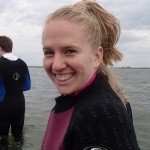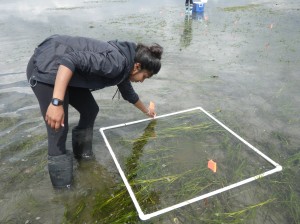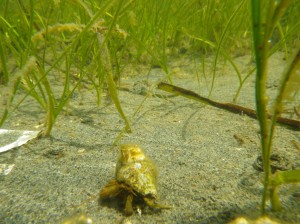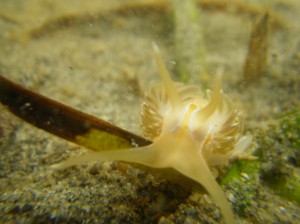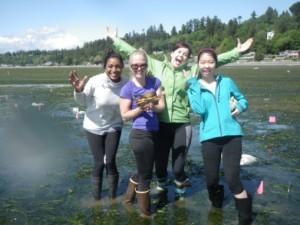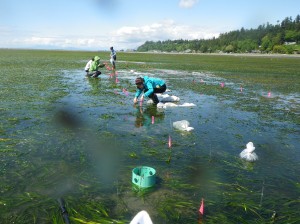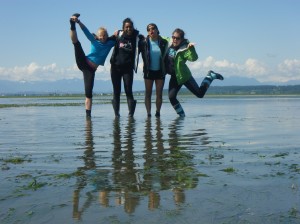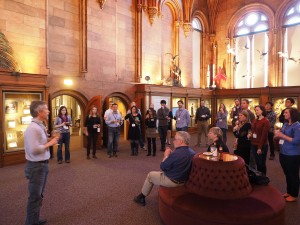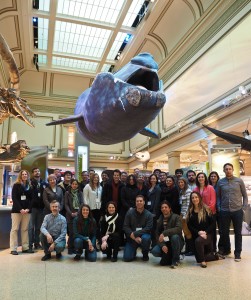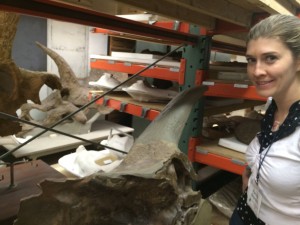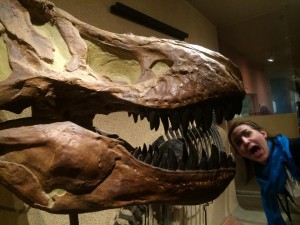Tsawwassen – home to big isopods, eelgrass and crabs
by Danielle Hall (College of William & Mary undergraduate student, ZENtern)
After three days of intense lab preparation and field work, the first ZEN2 site has been completed!
I arrived in British Columbia late on May 15th and the next day we got straight to work. After prepping materials in the lab we hopped in the lab truck and headed to our field site in a town outside of Vancouver called Tsawwassen. This particular site is in an intertidal zone and we chose to work on the lowest tide of the year since, during any other time, the site would be submerged and difficult to access.
To get to the site we climbed down over two hundred steps. Next, in our fashionable rubber boots, we hiked our way through the mud to get to our site (a treacherous task since the mud had a habit of clinging to our boots). On more than one occasion help was required to extricate a sunken foot.
I was amazed at the size of the Zostera shoots. They were nearly twice the size of the eelgrass in my home field site in Virginia! Not only were the shoots large, but the isopods were comparatively gigantic as well.
I was joining on day two of the field work and so the 20 experimental plots were already marked with orange flags. On this day, our job was to deploy the predation assay. The purpose of this assay is to understand the relative predation rates across the different ZEN site. The experimental units, or ‘PTUs,’ consist of a piece of bait tethered to an acrylic rod. The baits ranged from local animals, like the giant isopods, to a standard control, a piece of cut dried squid. A PVC quadrat helped visualize where to place our PTUs.
Having spent several summers helping deploy previous ZEN projects in the Chesapeake Bay, I was very curious to discover the differences in eelgrass beds between the two coasts. Here, anemones abounded right on the eelgrass shoots. I was amazed that they were able to make a living on plant tissue since in all my past experiences I had only ever seen anemones attached to a hard substrate (There are anemones living in eelgrass beds in the Chesapeake Bay as well, but they are generally small and scarce.)
Our lab group got particularly excited about a pair of nudibranchs who then became the stars of a Hollywood-esque photoshoot. Meanwhile a bald eagle joined us for a bit, clearly finding a tasty meal within the seagrass.
Our second day in the field was filled with surprises. After recording the results of the predation assay (the bait was either gone – eaten, presumably – or present), we continued with collecting samples. After combing through the plots at least two times, Celine – another ZEN participant – uncovered quite a surprise: a huge Dungeness crab hiding in the mud! And he was not too happy that we were intruding in his home. One of the other women, Jemma, mustered up the guts to pick up the feisty crab, and we all gathered around to take a picture with our new friend.
Day two was a long afternoon of working in our plots. So long in fact that the tide decided to turn despite the fact that we still had half our plots to process. A race ensued. We were optimistic. The tide was persistent. We lost. I was in the process of taking sediment core samples when I noticed the tide line getting ever so close, though I was determined to finish. When I peeked over my shoulder, I decided I could finish three more plots. I didn’t even finish the one I was on. Soon water was rushing into our site.
I abandoned my own task to help others finish collecting algae. We developed an effective method of the two hand scoop, where we quickly ran both hands through the plot to work like a sieve. Soon the water engulfed our boots which was followed by multiple exclamations, but together we finished all the plots. Looking towards the shore, our samples and coolers were being carried by the tide. It took all our effort to traverse back to the shore, and on the way retrieve the heavy, runaway samples.
Danielle is a rising senior at the College of William and Mary. As a ZENtern she will be working with the lab of Dr. Mary O’Connor at the University of British Columbia in Vancouver, as well as back at the Virginia Institute of Marine Science with Dr. Emmett Duffy’s Marine Biodiversity Lab during summer 2014. She has been volunteering in Dr. Duffy’s lab for the past two years and is from Massachusetts. Aside from her passion for science, Danielle is an avid dancer.
A ZEN conference at the Smithsonian
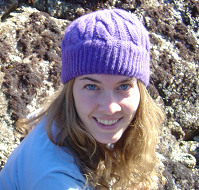 by Pamela Reynolds (ZEN postdoc and coordinator)
by Pamela Reynolds (ZEN postdoc and coordinator)
This month ZEN partners from across the globe gathered in Washington DC at the Smithsonian’s Museum of Natural History to discuss their research and new directions for the ZEN program. The meeting combined a symposium, which reported research completed during the first generation of ZEN (2011 – 2013), with an interactive workshop to plan for ZEN 2 (2014 – 2016). Returning and new ZEN partners, including site PIs, postdocs, and graduate and undergraduate students attended the meeting. Partners presented talks and posters throughout the 4-day conference. The research primarily focused on comparative community and functional ecology of eelgrass ecosystems, including interactions between bottom-up and top-down forcing, and links between biodiversity—at genetic, taxonomic, and functional levels—and ecosystem processes. The meeting was a great opportunity to engage in person with the diverse assemblage of seagrass biologists and ecologists within the ZEN network.
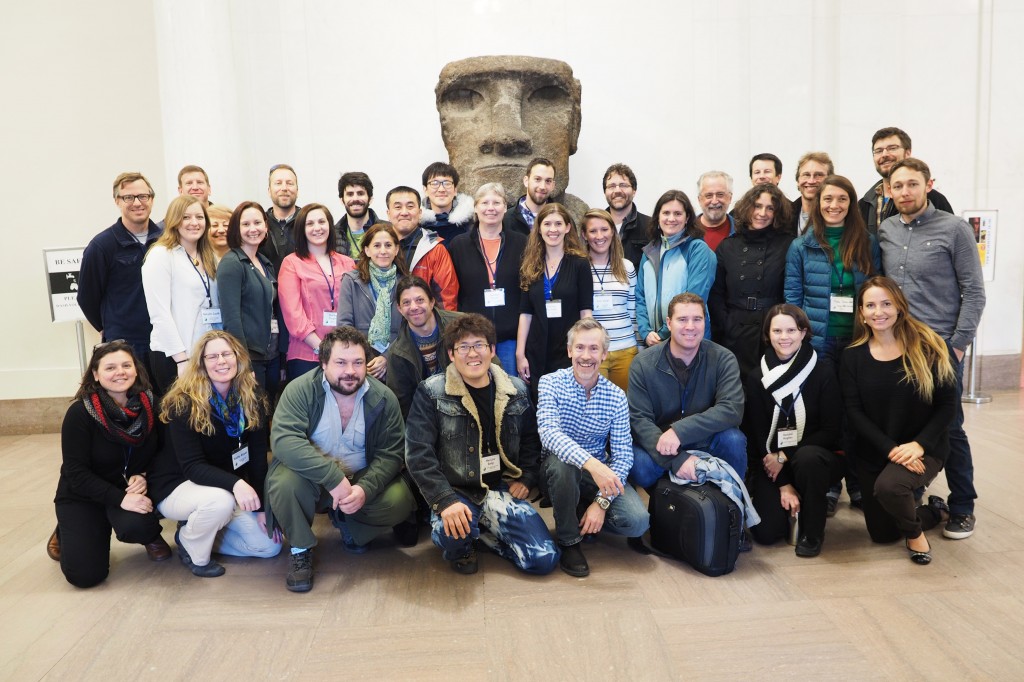
The ZEN 2014 working group conference at the Smithsonian Museum of Natural History in Washington DC, USA
This working group meeting was supported by The Zostera Experimental Network (NSF OCE-1031061 and OCE-1336206) and the Smithsonian Institution.
This meeting also marked the first trip to the USA for several of the conference attendees, and we were very excited to show off our nation’s capital. We are very grateful to the Smithsonian staff who helped with the logistics of the meeting, which included organizing a special welcome reception at the Smithsonian Castle and a special behind the scenes tour of the collections. We may be marine ecologists, but seeing a triceratops skull, sloth dung, and mammoth fur (along with a 3-d printer model of an active dig site) up close was a real treat!
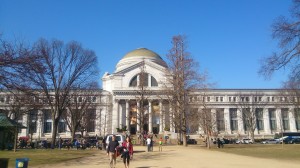
ZEN partners met at the Smithsonian Museum of Natural History in March 2014 to discuss past, current and future seagrass ecology research by the network
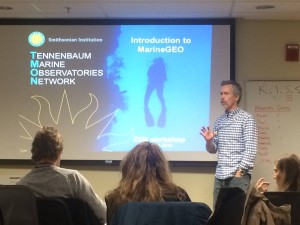
Dr. Emmett Duffy also discussed TMON – the Smithsonian Tennenbaum Marine Observatories Network – program with the ZEN partners
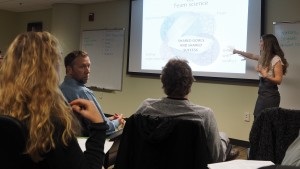
During the meeting Pamela discussed the importance of leveraging team science for the ZEN program. She will be leading a special session on this topic at the annual Ecological Society of America meeting in Sacramento this August.
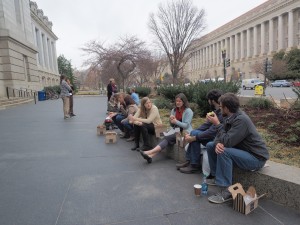
We couldn’t get enough science during the 4-day conference and even spent the lunch breaks discussing research plans
Photos contributed by Jonas Thormar, Paul Richardson, Massa Nakaoka, and Pamela Reynolds.
The next generation of ZEN!
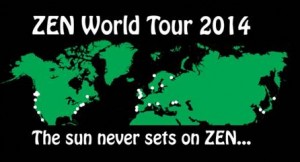 We are excited to announce that the Zostera Experimental Network has been funded by a Biological Oceanography grant at the National Science Foundation through summer 2016. In the next generation of the ZEN program we are expanding from 15 to over 50 sites worldwide in our quest to understand the role of biodiversity and the environment on the functioning of coastal ecosystems. As we move toward publishing the initial research from the first phase of the ZEN program, we are also planning the upcoming fieldwork which will take place across the globe. It is a very busy, but exciting time for ZEN! Check back for more updates throughout the ZENScience website as we launch this new phase of the project.
We are excited to announce that the Zostera Experimental Network has been funded by a Biological Oceanography grant at the National Science Foundation through summer 2016. In the next generation of the ZEN program we are expanding from 15 to over 50 sites worldwide in our quest to understand the role of biodiversity and the environment on the functioning of coastal ecosystems. As we move toward publishing the initial research from the first phase of the ZEN program, we are also planning the upcoming fieldwork which will take place across the globe. It is a very busy, but exciting time for ZEN! Check back for more updates throughout the ZENScience website as we launch this new phase of the project.

